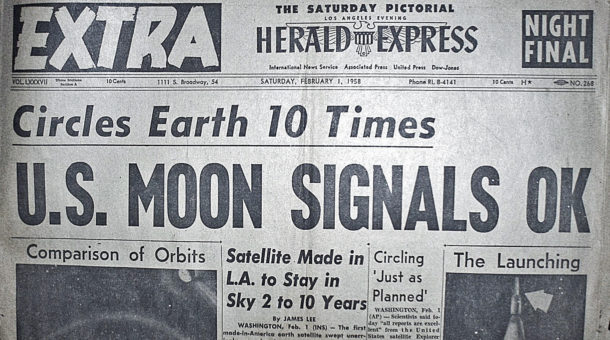
Fifty-nine years ago today, the United States successfully orbited the country’s first satellite. Known as Explorer I, the artificial moon went on to discover the system of radiation belts that surrounds the space environment of the Earth.
The Explorer I satellite was designed and fabricated by the Jet Propulsion Laboratory (JPL) under the direction of Dr. William J. Pickering. The satellite’s instrumentation unit measured 37.25 inches in length, 6.5 inches in diameter, and had a mass of only 18.3 lbs. With its burned-out fourth stage solid rocket motor attached, the total on-orbit mass of the pencil-like satellite was 30.8 lbs.
Explorer I was launched aboard a Jupiter-C (aka Juno I) launch vehicle from LC-26 at Cape Canaveral, Florida on Friday, 31 January 1958. Lift-off at occurred at 22:48 EST (0348 UTC). With all four stages performing as planned, Explorer I was inserted into a highly elliptical orbit having an apogee of 1,385 nm and a perigee of 196 nm.
Arguably the most historic achievement of the Explorer I mission was the discovery of a system of charged particles or plasma within the magnetosphere of the Earth. These belts extend from an altitude of roughly 540 to 32,400 nm above mean sea level. Most of the plasma that forms these belts originates from the solar wind and cosmic rays. The radiation levels within the Van Allen Radiation Belts (named in honor of the University of Iowa’s Dr. James A. Van Allen) are such that spacecraft electronics and astronaut crews must be shielded from the adverse effects thereof.
Explorer I operational life was limited by on-board battery life and lasted a mere 111 days. However, it soldiered-on in orbit until reentering the Earth’s atmosphere over the Pacific Ocean on Tuesday, 31 March 1970. During the 147 months it spent in space, Explorer I orbited the Earth more than 58,000 times. Data obtained and transmitted by the satellite contributed markedly to mankind’s understanding of the Earth’s space environment.
Perhaps the greatest legacy of Explorer I was that it was the first satellite orbited by the United States. Unknown to most today, this accomplishment was absolutely vital to America’s security, and indeed that of the free world, at the time. The Soviet Union had been first in space with the orbiting of the much larger Sputnik I and II satellites in late 1957. However, Explorer I showed that America also had the capability to orbit a satellite. History records that this capability would quickly grow and ultimately lead to the country’s preeminence in space.
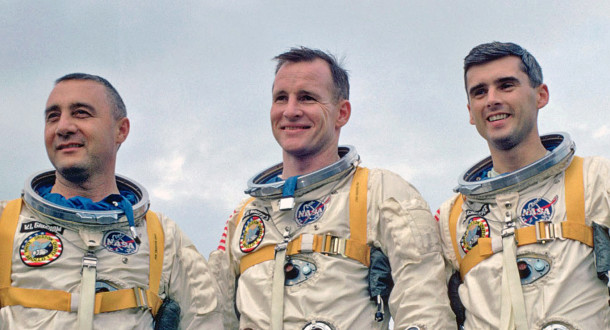
Fifty years ago to the day, the Apollo 204 prime crew perished as fire swept through their Apollo Block I Command Module (CM). The Apollo 204 crew of Command Pilot Vigil I. “Gus” Grissom, Senior Pilot Edward H. White II and Pilot Roger B. Chaffee had been scheduled to make the first manned flight of the Apollo Program some three weeks hence.
On Friday, 27 January 1967, during a plugs-out ground test on LC-34 at Cape Canaveral, Florida, a fire broke out in the Apollo 204 spacecraft at 23:31:04 UTC (6:31:04 pm EST). Shortly after, a chilling cry was heard across the communications network from Astronaut Chaffee: “We’ve got a fire in the cockpit”.
Believed to have started just below Grissom’s seat, the fire quickly erupted into an inferno that claimed the men’s lives in less than 30 seconds. While each received extensive 3rd degree burns, death was attributed to toxic smoke inhalation.
The Apollo 204 fire was most likely brought about by some minor malfunction or failure in equipment or wire insulation. This failure, which was never positively identified, initiated a sequence of events that culminated in the conflagration.
The post-mishap investigation uncovered numerous defects in CM Block I design, manufacturing, and workmanship. The use of a (1) pure oxygen atmosphere pressurized to 16.7 psia and (2) complex 3-component hatch design (that took a minimum of 90 seconds to open) sealed the astronauts’ fate.
A haunting irony of the tragedy is that America lost her first astronaut crew, not in the sideral heavens, but in a spacecraft that was firmly rooted to the ground.
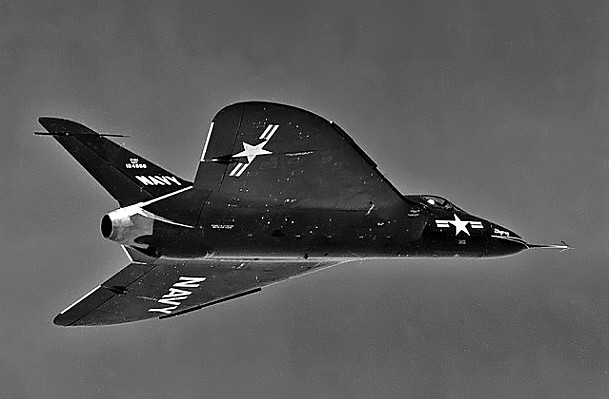
Sixty-four years ago this month, the USN/Douglas XF4D-1 Skyray fighter flew for the first time at Edwards Air Force Base in California. Douglas test pilot Robert O. Rahn was at the controls of the single-engine, carrier-based, supersonic-capable aircraft.
The Douglas XF4D-1 was the prototype version of the United States Navy’s F4D-1 Skyray. Designed to intercept adversary aircraft at 50,000 feet within 300 seconds of take-off, development of the Skyray began in the late 1940’s. As an aside, the Skyray nickname derived from the type’s large delta wing which gave it the appearance of a Manta ray.
The Skyray was originally designed to be powered by a Westinghouse XJ40-WE-6 turbojet capable of 7,000 lbs of sea level thrust. However, when significant developmental problems were encountered with that power plant, Douglas substituted an Allison J35-A-17 turbojet to support early flight testing of the XF4D-1. With a maximum sea level thrust of 5,000 lbs, the J35 rendered these early airframes significantly underpowered.
A pair of XF4D-1 Skyray airframes were built by Douglas. Ship No. 1 was assigned tail number BuAer 124586 while Ship No. 2 received the designation BuAer 124587.
On Tuesday, 23 January 1953, XF4D-1 Ship No. 1 (BuAer No 124586) departed Edwards Air Force Base on its first ride into the wild blue. Doing the piloting honors on this occasion was highly regarded Douglas test pilot Bob Rahn. The delta-winged beauty performed well on this maiden flight which concluded with Rahn making an uneventful landing back at Edwards.
Extensive flight testing of the Skyray, including carrier trials, continued through 1955. The Westinghouse XJ40-WE-8 appeared on the scene during this time. Rated at 11,600 lbs of sea level thrust in afterburner, this power plant allowed the Skyray to establish several speed records in California during October of 1953. Specifically, a speed of 752.944 mph was registered within a 3-kilometer course over the Salton Sea followed by 100-kilometer closed course mark of 728.11 mph at Edwards AFB.
Unfortunately, the XJ40 would prove to be very temperamental and unreliable. Inflight engine fires, explosions, and component failures constantly plagued the Skyray program. Westinghouse never did solve these problems to the satisfaction of the Navy. As a result, the service eventually opted to power production aircraft with the Pratt and Whitney J57-P-8 turbojet (10,200 lbs of sea level thrust).
The Douglas F4D-1 Skyray went on to serve with the United States Navy and Marines from 1956 through 1964. A total of 420 aircraft were produced. While never used in anger, the Skyray was a solid performer and served well in its intended role as a point design interceptor.
The Skyray holds the distinction of being the last fighter produced by the Douglas Aircraft Company before this legendary aerospace giant merged with McDonnell Aircraft to form McDonnell Douglas.
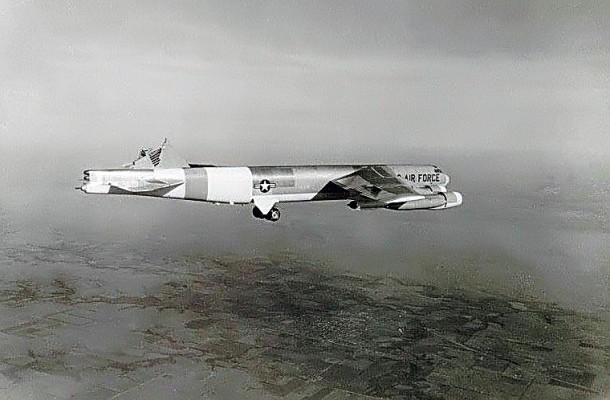
Fifty-three years ago this week, a USAF/Boeing B-52H Stratofortress landed safely following structual failure of its vertical tail during an encounter with unusually severe clear air turbulence. The harrowing incident occurred as the aircraft was undergoing structural flight testing in the skies over East Spanish Peak, Colorado.
Turbulence is the unsteady, erratic motion of an atmospheric air mass. It is attributable to factors such as weather fronts, jet streams, thunder storms and mountain waves. Turbulence influences the motion of aircraft that are subjected to it. These effects range from slight, annoying disturbances to violent, uncontrollable motions which can structurally damage an aircraft.
Clear Air Turbulence (CAT) occurs in the absence of clouds. Its presence cannot be visually observed and is detectable only through the use of special sensing equipment. Hence, an aircraft can encounter CAT without warning. Interestingly, the majority of in-flight injuries to aircraft crew and passengers are due to CAT.
On Friday, 10 January 1964, USAF B-52H (S/N 61-023) took-off from Wichita, Kansas on a structural flight test mission. The all-Boeing air crew consisted of instructor pilot Charles Fisher, pilot Richard Curry, co-pilot Leo Coors, and navigator James Pittman. The aircraft was equipped with accelerometers and other sensors to record in-flight loads and stresses.
An 8-hour flight was scheduled on a route that from Wichita southwest to the Rocky Mountains and back. The mission called for 10-minutes runs of 280, 350 and 400 KCAS at 500-feet AGL using the low-level mode of the autopilot. The initial portion of the mission was nominal with only light turbulence encountered.
However, as the aircraft turned north near Wagon Mound, New Mexico and headed along a course parallel to the mountains, increasing turbulence and tail loads were encountered. The B-52H crew then elected to discontinue the low level portion of the flight. The aircraft was subsequently climbed to 14,300 feet AMSL preparatory to a run at 350 KCAS.
At approximately 345 KCAS, the Stratofortress and its crew experienced an extreme turbulence event that lasted roughly 9 seconds. In rapid sequence the aircraft pitched-up, yawed to the left, yawed back to the right and then rolled right. The flight crew desperately fought for control of their mighty behemoth. But the situation looked grim. The order was given to prepare to bailout.
Finally, the big bomber’s motion was arrested using 80% left wheel authority. However, rudder pedal displacement gave no response. Control inputs to the elevator produced very poor response as well. Directional stability was also greatly reduced. Nevertheless, the crew somehow kept the Stratofortress flying nose-first.
The B-52H crew informed Boeing Wichita of their plight. A team of Boeing engineering experts was quickly assembled to deal with the emergency. Meanwhile, a Boeing-bailed F-100C formed-up with the Stratofortress and announced to the crew that most of the aircraft’s vertical tail was missing! The stricken aircraft’s rear landing was then deployed to add back some directional stability.
With Boeing engineers on the ground working with the B-52H flight crew, additional measures were taken in an effort to get the Stratofortress safely back on the ground. These measures included a reduction in airspeed, controlling aircraft center-of-gravity via fuel transfer, judicious use of differential thrust, and selected application of speedbrakes.
Due to high surface winds at Wichita, the B-52H was vectored to Eaker AFB in Blytheville, Arkansas. A USAF/Boeing KC-135 was dispatched to escort the still-flying B-52H to Eaker and to serve as an airborne control center as both aircraft proceeded to the base. Amazingly, after flying 6 hours sans a vertical tail, the Stratofortress and her crew landed safely.
Safe recovery of crew and aircraft brought additional benefits. There were lots of structural flight test data! It was found that at least one gust in the severe CAT encounter registered at nearly 100 mph. Not only were B-52 structural requirements revised as a result of this incident, but those of other existing and succeeding aircraft as well.
B-52H (61-023) was repaired and returned to the USAF inventory. It served long and well after its close brush with catastrophy in January 1964. The aircraft spent the latter part of its flying career as a member of the 2nd Bomb Wing at Barksdale AFB, Louisiana. The venerable bird was retired from active service in July of 2008.
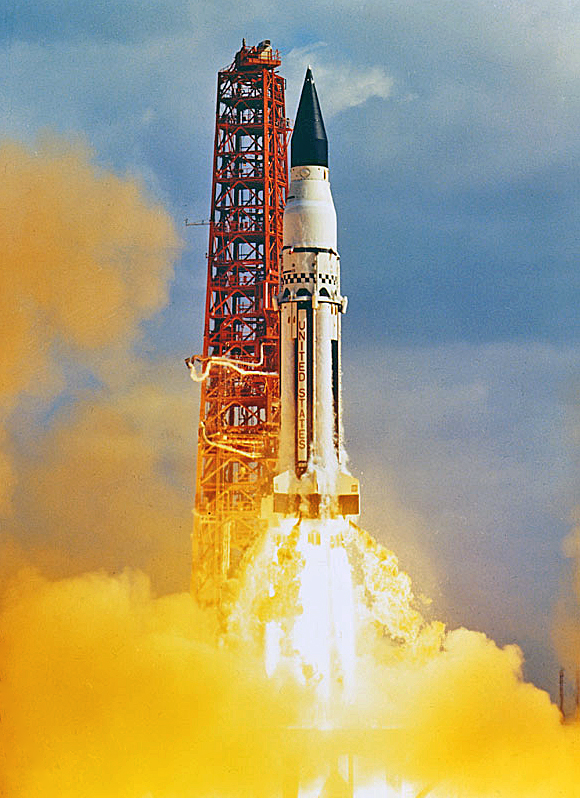
Fifty-three years ago this month, NASA successfully launched the first Saturn I Block II heavy-lift launch vehicle. Known as Saturn-Apollo No. 5 (SA-5), the mission featured the largest mass ever orbited up to that time in the history of spaceflight.
The Saturn I was a pathfinder rocket booster that ultimately lead to the development of the mighty Saturn V launch vehicle. Ten (10) Saturn I boosters were flown between October 1961 and July 1965. The first four (4) missions involved the Block I variant wherein only the first stage was powered. The final six (6) missions employed Block II vehicles which included live first and second stages.
The Saturn I measured 164 feet in length with a maximum diameter of 21.42 feet. The S-I first stage was powered by an octet of Rocketdyne H-1 engines that generated a total sea level thrust of 1,500,000 lbs. The S-IV seconds stage incorporated six (6) Pratt and Whitney RL10 engines rated at a total vacuum thrust of 900,000 lbs.
SA-5 was launched from LC-37 at Cape Canaveral, Florida on Wednesday, 29 January 1964. Weighing 1,121,680 lbs at first stage ignition, the vehicle lifted-off at 14:25:01 UTC. As the first and second stages functioned in splendid fashion, the second stage successfully achieved an elliptical orbit measuring 142 x 415 nm.
The SA-5 orbited mass of 37,700 lbs was a record for the time. This payload, consisting of the S-IV stage, an instrument unit, and a modified Jupiter nose cone filled with sand ballast, remained in orbit through the end of April 1966.
The SA-5 mission was significant for a variety of reasons. It featured the first live S-IV rocket stage and was the first Saturn I vehicle to achieve orbit. It also marked that moment in spaceflight history when America finally surpassed the Soviet Union in payload mass to orbit capability. Known as “closing the booster gap”, this event was an important step in the race to the moon in which America would be the ultimate victor.






